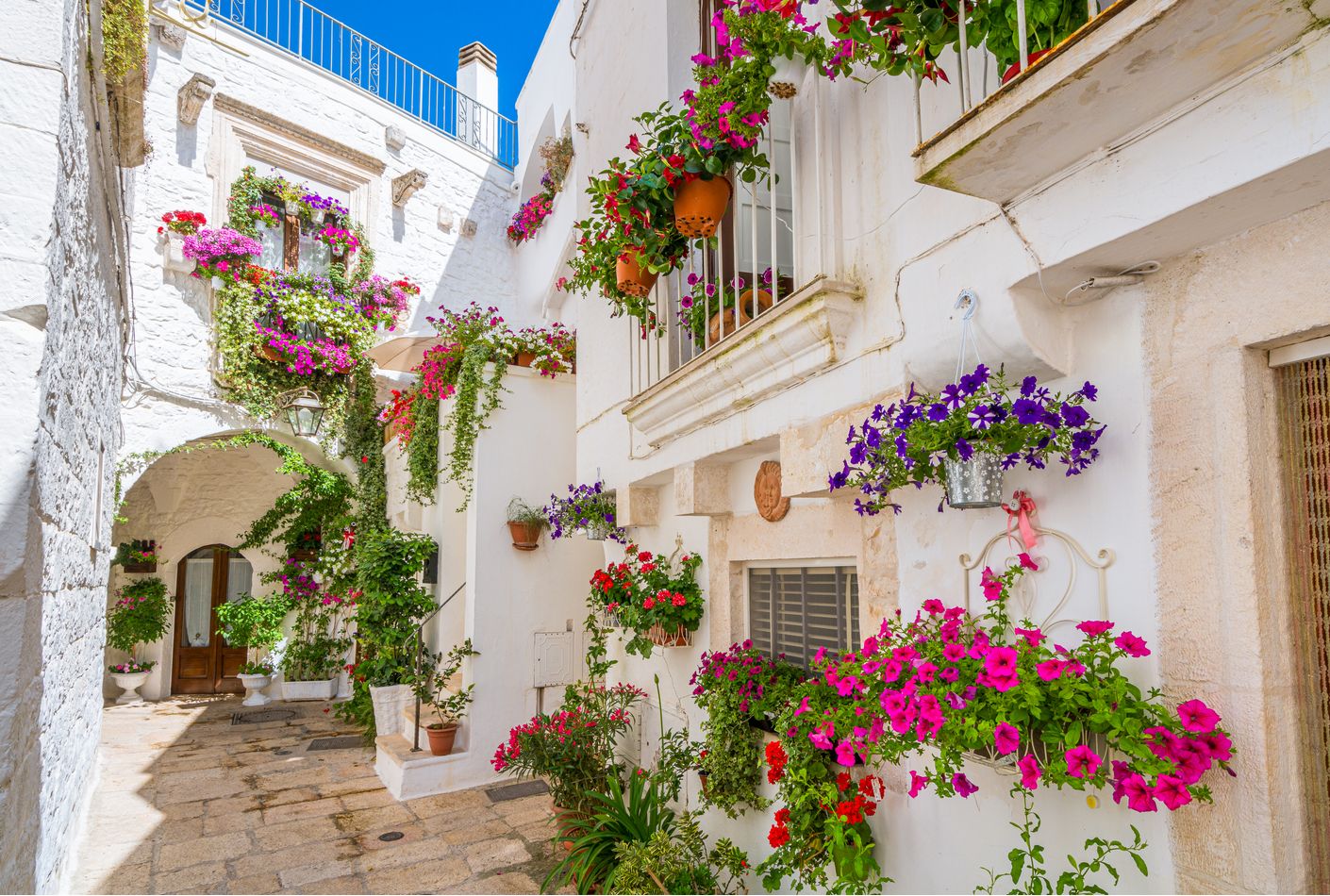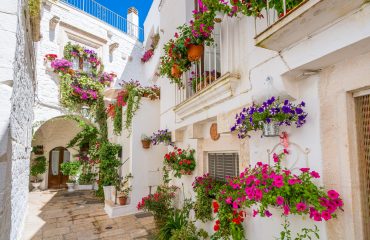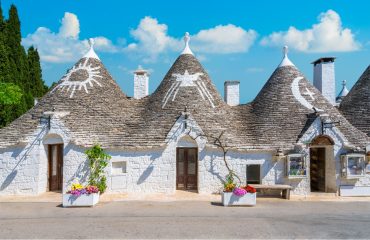THREE’S A CHARM
Day trip to Ostuni, Cisternino & Alberobello
- Step into Ostuni’s picture postcard beauty and weave your way along its shimmering white streets
- Gaze up to receive a blessing from Saint Nicola who surveys the entrance to Cisternino atop a 17-metre-tall medieval tower
- Discover how a 15th century tax fraud eventually led to the creation of a World Heritage Site as you admire Alberobello’s famous trulli
-
Category
-
Hobbies & Interests
-
DurationFull day
-
Destination
THREE’S A CHARM
Day trip to Ostuni, Cisternino & Alberobello
Explore an enchanting trio of Apulian towns on this full-day private tour of the Itria Valley. Your guide and chauffeur will meet you at your accommodation and drive you to the hilltop town of Ostuni. Bright chalky buildings line an intricate maze of twisting alleys and steep stairways, surrounded by the seemingly endless plains of olive groves. Scattered here and there painted wooden doors and pots of blooming geraniums lend additional splashes of vivid green, brilliant crimson and bright pink to the scene. Wonderful views of the countryside stretching all the way to the sapphire waters of the Adriatic Sea can be glimpsed between the houses. The 15th century Cathedral of Santa Maria Assunta, with its elegantly shaped facade, elaborate rose windows and splendid Gothic portals, proudly surveys the “White Dame” – as Ostuni is called – from the town’s summit.
Ostuni is a sheer delight and a must-see for anyone visiting Apulia. The town’s most distinctive trait is its whitewashed houses, gleaming in the dazzling light of the southern sun. The practice of lime washing became popular in the 18th century when a devastating plague struck the region. Locals noticed that the illness spread less easily in places where the houses were white and attributed this fact to a miracle, which we now know is probably due to the antibacterial effect of the calcium carbonate. The lime protected the town and, over the centuries, became the symbol of Ostuni and the very reason for the long-lasting fame of this Adriatic pearl. Your guide will lead you on a trail through narrow streets, up and down steps, across charming piazzette, allowing you to get to know the layout of Ostuni’s medieval neighbourhood and its most famous attractions.
A 20-minute drive will bring you to Cisternino, a small town boasting sweeping views of the surrounding Itria Valley. Founded by the Basilian monks in the 8th century AD, Cisternino preserves a medieval street plan which is still remarkably intact and punctuated with historic buildings, none seemingly less than two hundred years old. A meticulously assembled collage of narrow shady streets, whitewashed and cream-coloured houses, blooming balconies and tiny courtyards, all pasted onto a background of green fields and dry stone walls has survived to this day, providing a panorama for contemporary visitors that has hardly changed at all over the centuries. The entrance to the town in Piazza Garibaldi is dominated by the 17-metre-tall Norman-Swabian tower, topped by a statue of San Nicola, the patron saint of Cisternino. From here follow your guide through the old centre on a quest for its most famous landmarks. Worthy of note are the Mother Church of San Nicola, built over an earlier place of worship of the Basilian monks, Piazza Vittorio Emanuele III, overlooked by the 19th century clock tower, and a handful of noble residences dating between the 16th and 18th centuries, including the tower-flanked Palazzo Amati.
After some free time for lunch, rejoin your driver and reach the lovely town of Alberobello, world-known for its traditional trulli houses. Here you will discover how an ingeniously devised tax fraud curiously led to the creation of a UNESCO World Heritage Site. Trulli are whitewashed dwellings consisting of thick dry-stone walls assembled without mortar and topped by conical stone roofs. Bizarre as it may seem, these houses were originally designed in the late 15th century with the aim of fooling royal authorities and avoiding taxation, a successful trick that worked right up till 1797 when Alberobello acquired its status as a proper town. Indeed, until then, the local feudal lords, the shrewd Counts of Acquaviva, obliged their subjects to live inside trulli which could be quickly and easily dismantled. Taxation applied only to populated settlements and Alberobello could be transformed in no time into a vast expanse of rubble if the royal officers decided to inspect. Today these structures are still inhabited and constitute “an outstanding example of human settlement that retains its original form to a remarkable extent” as stated by the UNESCO committee. They also live on as a reminder of characteristic Italian artfulness. Enjoy a leisurely stroll along the town’s winding alleys lined with shops selling hand-painted ceramic artefacts, gastronomic specialities and all sorts of trulli-shaped souvenirs, before returning to your accommodation.
- A Mercedes vehicle and professional driver at your disposal for a full-day excursion to Ostuni, Cisternino and Alberobello
- A full-day private tour with an expert licensed guide
- Tips
- Meals
- The order of the sites visited may change





